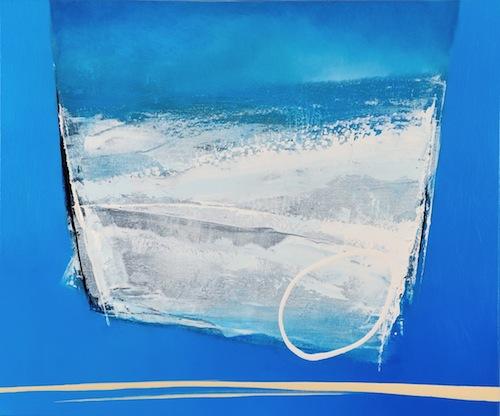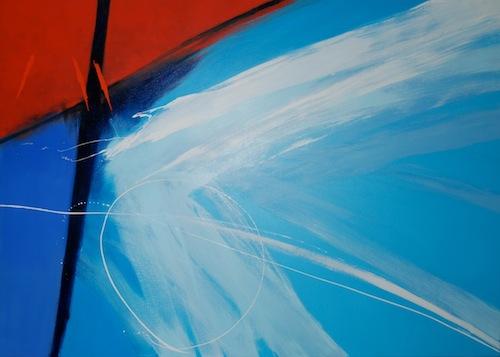Landscape is constantly in motion and changing over time; from the rapid movement of a wave, the flutter of a leaf, the subtle drift of a cloud, and the apparent solidity of a rocky outcrop. Casey writes about the challenge for a painter to Ìcontain something as overflowing as landscape within the very particular confines of a painting? Ì(1). Its representation has evolved from backdrops of portraits by Leonardo, into the foreground of traditional depictions by Constable. It inspired the St Ives School of painting and was incorporated into the abstractions of Heron:
ÌThe art of painting, he once declared, is evoking space through colour....The shapes and colours around him - the blunted oblongs of the rocks, the meandering boundaries of the prehistoric fields, the purples and pinks of his garden, the violet and turquoise of the sea - all these have seeped into his mind over many years. The land, sea, and the celebrated St Ives light, are constantly there. Ì (2)

Beach Life, oil on canvas, 76 x 91 cm
Canning Ìs creative process builds on the foundations of the St Ives School, manages to transcend the restrictions of representation and containment, and has been proclaimed the expression of a world in Ìconstant flux Ì(3). His artworks have been described as a Ìparadigm of Cornwall Ìs rock formations and its sea-borne wind and weather, inspired by the energy of the place itself Ì(4). Informed by the creative practice of Lanyon (5) ; walking through a landscape and absorbing the energies, shapes, and colour Ìs comprising the available visual information, Canning could be said to be absorbing the essence of the landscape. The absence of a sketchbook or digital camera, means that he is not distracted by individual details, but allows himself to descend deeper into the spirit of the place. Retreating to his silent studio, devoid of the music of nature, he is free of distractions and able to express the essence of the experience. His process could be said to mirror that of nature itself, patient layers of colours complimented by dramatically energetic outbursts. The absence of a pre-concieved notion of the final artwork serves to keep his mind free of intention, so that an artwork emerges from the surface of the canvas as a trace memory of the place.
This exhibition is essentially a retrospective of recent work, and can be split into two distinct groups. Firstly, his most well known works could be described as vibrant abstract depictions of the physical landscape of the Penwith Peninsula. Therefore this style could be prounounced as the expression of external landscape (6). The titles are linked to specific places such as Lizard Point, expressions of the state of the sea such as Storm Surge, or the time of day as in First Light. They are brightly coloured, aesthetically pleasing, and display signatory circles, intercrossing lines and splashes. These works have been described as ÌLandscapes of the Mind Ì(7), typified by seductive and harmoniously balanced colours. They could be said to exhibit a visual affect called ‘ocular spectra, that is the coloured after-images perceived when a patch of a particular colour is looked at closely for a considerable time. The after- image of a patch seemed to be its complement’(8) . Amazingly, the colour you have stared at switches in your mind to its its opponent (9) , so white becomes black, red shifts to green, and blue changes to yellow. I invite you to explore this within Canning Ìs work, and be astonished by the visual harmony of the images, with the after-images (10) mirroring the painted images. In addition to this observation, you may find that green is rarely used in the works, but there is evidence of red in a variety of hues, which could be referenced as a visual trace memory of the experience of a green landscape.

Cross Course, oil on canvas, 153 x 213 cm
The second style, as expressed in his recent New York series, could be described as an exploration of internal Landscape (11), specifically an informed human dimension to landscape. The sombre colour balance of the work is a discernible contrast to his earlier works, and conceptually I feel that the work explores new terrain, expressing the nature of the artist in contemporary society. Instead of responding directly to the visual landscape, it extends into the experienced landscape as a consequence of real-time reporting and our interconnected world. LIke the after-images of colours evident in the earlier works, this series delves deeper into the memories of events connected to places, not directly experienced by the artist, but part of the collective experience and expression of place. To me the artwork simply entitled New York skyline, has a far reaching depth of meaning: remembering the events of 9/11. The sculptural form of the remaining metal structure softened by the dense smoke of confusion, contrasting with the square grid format of the city Ìs streets, and the sunken pools that remain as a memorial to the Twin Towers.

New York Skyline, oil on canvas, 180 x 70 cm
Perhaps it seems morbid to acknowledge the motive comprising of nine gestural brushmarks as symbolic of the falling bodies, but they existed, and however emotive, exist in this work. Towards the bottom, the blood red sea is cut by a yellow line in the foreground. Do they signify the distinctive colour of the parking lines? or the pulse of the city after the attacks? The nearly 3000 lives suddenly and tragically expired.
The internationally recognized artist Gerhard Richter (12) , and the St Ives based artist Roy Ray (13) , have both explored 9/11 within their own practice. Could the inspiration for the New York Series be described as shifting from understanding and expressing the physical world, to the realm of comprehending human nature? As if to guide the viewer out of the intensity of the dialogue, the use of the number nine can be seen as an esoteric reference. The lu-shu (14) magic square of nine numbers, whose significance bridges the distinct world religions and cultures, has been more than 4000 years in existence and can be described as both harmonious and sacred. In addition, it can be interpreted as a geographical reference to the eight wind directions, with the ninth point as the centre. Ultimately the choice to depict nine gestural brushmarks could be summarized as a reference to Tao, expressing a harmony with the natural order of the universe.
Therefore I propose that the human dimension to his recent work could be described as conceptually linked to the essence of experience in the earlier physical landscape abstractions. In the words of the artist himself Ìart effects the way we see the world - it helps us to make sense of the complex and constantly changing world around us Ì(15). The acknowledgment that we do not necessarily understand how or why things happen, results in the artworks in general becoming an expression of the energy of nature itself.
I encourage you to see this exhibition and explore the trace memory of Landscape, as experienced by the artist and expressed in his artworks.
Preview: Neil Canning - A Trace Memory of Landscape by Natasha Hall. Natasha is a Practising Artist researching for a Phd on Contemporary Landscape who wrote the preview after interviewing Neil Canning.
Viewing is by appointment only and is possible during office hours, Monday to Friday, 9am to 5pm. Appointments can be made by calling 020 7767 6721.
Neil Canning’s painting Ocean Current was the winner of the ING Purchase Prize at the ING Discerning Eye Exhibition in 2011 (http://www.discerningeye.org/archive/2011/2011_3.php).
ING has sponsored the Discerning Eye Exhibition since 1999. The annual exhibition showcases work (2d and 3d) chosen by six selectors - two collectors, two critics, and two artists. All the work is for sale. There is a size limit on the work - it must be 20" x 20" or less. Work is selected from a nationwide open submission and for a certain percentage of their total selection, selectors invited artists of their choice.